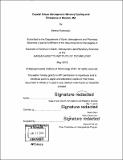Coastal urban atmospheric mercury cycling and emissions in Boston, MA
Author(s)
Rutkowski, Emma.
Download1120769379-MIT.pdf (13.57Mb)
Other Contributors
Massachusetts Institute of Technology. Department of Earth, Atmospheric, and Planetary Sciences.
Advisor
Noelle Selin.
Terms of use
Metadata
Show full item recordAbstract
This study aims to contribute to the body of knowledge regarding mercury emissions by reporting on a coastal, urban setting subject to inputs from both anthropogenic and oceanic reservoirs, in order to improve related policy decisions. Mercury can have serious health and ecological consequences, but the chemistry, transport and deposition of gaseous elemental mercury (Hg0) are still not well understood. Estimates of anthropogenic emissions also remain uncertain. To better constrain urban- and regional-scale chemistry and emissions in a specifically coastal environment, concentrations of Hg0 were measured at an urban site in Boston, MA from Aug 2017 to Sept 2018. The recorded concentrations were compared against supplementary records of several additional pollutants and meteorological variables. Concentrations in Boston were found to be relatively low, but follow diurnal and seasonal trends previously observed in other sites in the United States driven by meteorology. Further, back-trajectory and potential source contribution function analysis revealed oceanic re-emission of legacy deposits is a major input of Hg0 to the Boston area, but no influence from specific large anthropogenic point sources was discernible in the data. A one box model was developed to represent the physical processes controlling Hg0 concentrations in Boston in order to replicate concentrations, capture the difference in concentrations from land and ocean sources, and estimate both anthropogenic and oceanic emissions. Results from the box model analysis show the sensitivity of local Hg0 concentrations to varying assumptions of mixing, background flux, meteorology, and emissions, and indicate that oceanic emissions and anthropogenic emissions are likely both higher than current estimates. The results of this study indicate the ocean plays a major role in Hg0 cycling in coastal areas and provides motivation for further improvement of models to better capture local sources and cycling.
Description
Thesis: S.B., Massachusetts Institute of Technology, Department of Earth, Atmospheric, and Planetary Sciences, 2019 Page 57 blank. Cataloged from PDF version of thesis. Includes bibliographical references (pages 48-52).
Date issued
2019Department
Massachusetts Institute of Technology. Department of Earth, Atmospheric, and Planetary SciencesPublisher
Massachusetts Institute of Technology
Keywords
Earth, Atmospheric, and Planetary Sciences.